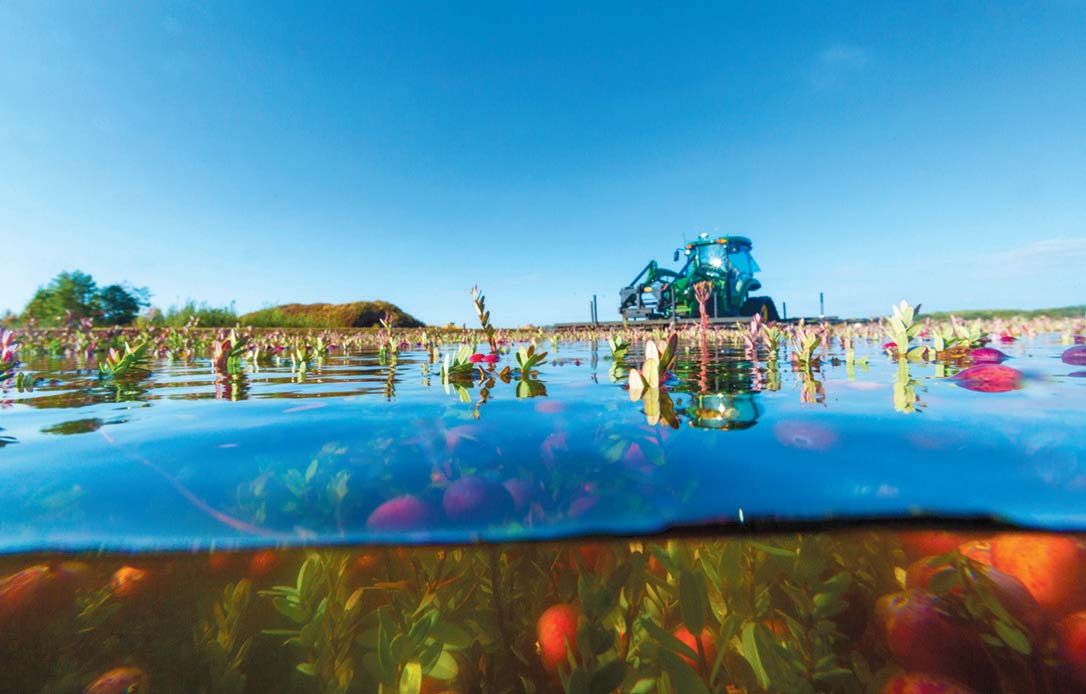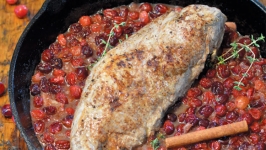Sassamenesh is more popular than you may think

Cranberry harvest. Photo contributed by the Wisconsin State Cranberry Growers Association
September 22 marks the official start of autumn. It’s a time to switch culinary gears and start enjoying all the produce the season has to offer and wave goodbye to summer produce. It’s time to say hello to apples, pears, winter squash and sassamenesh.
You haven’t heard of sassamenesh? You’ve probably enjoyed several helpings at Thanksgiving dinner. Or perhaps you’ve enjoyed them in dried form in a morning muffin or scone. Sassamenesh is the Algonquin name for Wisconsin’s state fruit and number one fruit crop: the cranberry.
The tiny tart berry also holds the title of one of our country’s original native fruits. Early settlers referred to the fruit as “crane berry” due to the cranberry bud’s resemblance to the sandhill crane. Crane berry ultimately morphed into cranberry, which is a bit easier to pronounce than sassamenesh.
A PERFECT GROWING ENVIRONMENT
Wisconsin is the leader in cranberry production, growing over 60 percent of our country’s annual harvest. Over 250 Wisconsin cranberry growers provide in excess of 500 million pounds annually of the red tart berries. Why is Wisconsin the top cranberry producer? The state’s soil, weather and resources create the perfect environment for a strong cranberry business.
“Cranberries thrive in an acidic, sandy soil needed for drainage. Sand is a very important element in cranberry production,” explained Tom Lochner, executive director of the Wisconsin State Cranberry Growers Association. “There’s a large area in central Wisconsin that was known as the sand swamps. It’s a wetland area that was carved out by glaciers. Cranberries grew in this area, and early settlers started to culativate them. Those areas grew into the industry that we have today.”
The cranberry is a perennial plant and needs to go into dormancy during the winter. And winter is definitely something Wisconsin can offer.
“Every three to four years, growers flood the beds and add ice to them. Then they drive trucks out and put a layer of sand on, so when the ice melts, the sand goes into the ground, aiding in next year’s growing process,” Lochner explained.
THEY FLOAT BUT DON’T GROW IN WATER
One of the biggest misconceptions about cranberries is the belief that the fruit grows in water. Cranberries grow on a low-lying vine layered with sand, peat, gravel and clay. The growing area is referred to as a cranberry marsh or bog.
But what about all those colorful photos of cranberries floating in the marshes? When ready to harvest, growers flood the cranberry marsh. Cranberries contain a small pocket of air, and when flooded the tiny berries fl oat to the surface, just waiting to be harvested. The flooding aids in harvesting the fruit and makes for some stunning autumn photos.
AN ENVIRONMENTALLY FRIENDLY CROP
Not only is the cranberry an important crop financially for Wisconsin, it also helps support our native habitat.
“In general, marshes are composed of two areas,” explained Lochner. “One is where the vines actually grow. The rest of the property is called support land with water storage reservoirs and wild wetland areas surrounded by woods. It’s a functioning part of the farm but also protects the wildlife.”
Typically, every one acre in cranberry production includes another 6.3 acres of land that is conserved as wildlife habitat. Cranberry growers look forward to spring not only to see how their cranberry vines have weathered the winter, but also to enjoy the ever-changing wildlife habitat of the area. “We’ll often see trumpet swans, loons, whooping and sandhill cranes, wolves and coyotes on the land,” said Lochner.

Cranberries. Photo contributed by the Wisconsin State Cranberry Growers Association
A VERSATILE AND NUTRIENT-RICH INGREDIENT
Tart cranberries are considered a super food. The berries are low in calories but high in vitamin C, A and K. In disease-fighting antioxidants, cranberries outrank nearly every fruit and vegetable. One cup of whole cranberries has 8,983 total antioxidant capacity. Only blueberries surpass the mighty cranberry.
Often associated with Thanksgiving Day dinner, only 5 percent of the crop is actually sold fresh during the autumn season. The remaining fruit is frozen or processed into juice, canned sauces and dried cranberries. Although the fruit is only available fresh once a year, usually September through late October, it can be found year-round in a variety of forms. Look for bags of individually frozen cranberries at your favorite grocery store, or stock up on fresh berries when they are plentiful during the fall and freeze them yourself.
Don’t relegate the mighty cranberry to just a Thanksgiving side dish. This versatile fruit has much more to offer in the culinary arena.
A cast-iron skillet is the perfect resting place for a roast pork tenderloin and a few cups of fresh cranberries. Bring the tastes and aromas of fall together by dusting the pork with ground cinnamon and a generous sprinkle of salt and pepper. After a quick sear to lock in the pork juices, remove the tenderloin and sauté diced onion and fresh cranberries in the same skillet. A drizzle of maple syrup (Wisconsin-made, of course) and fresh sprigs of rosemary and thyme flavor the mixture. Place the pork back in the pan, nestling it between the ruby red berries, and give it a hot roast in the oven.
Dried cranberries are great for snacking or putting on your morning yogurt or cereal. They also provide a pop of color and flavor to a raw salad. Toss together autumn produce favorites like Brussels sprouts, kale and apples to create the perfect fall salad. Visit your local farmers market and pick up some tart red apples to create the perfect topping for your salad creation.
For sipping, try an adult version of cranberry juice. The perfect sipper for the season, the bounce is simply made with fresh cranberries, sugar, orange zest and your favorite vodka. The only downside? You have to give the mixture a good rest for a few weeks before enjoying that first taste.








